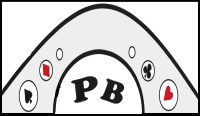Mini-bridge is a version of the game which omits the bidding at the beginning. This is ideal for complete beginners who want to learn the basic mechanics and aims of the game.
As in normal bridge, mini-bridge is played by four people playing in two partnerships. Players will be assigned a compass direction. North and South are partners and so are East and West. Of the four players one will always be designated as dealer, even if you are not physically dealing. The dealer on hand one will be North and it rotates clockwise around the table for each hand.

In mini-bridge you will be dealt a hand of 13 cards. Your first job should always be to count your cards and make sure you have 13 (of course you dont need to worry about this online!).
Your next job is to sort your hand. Group the suits together and order them from highest to lowest. In bridge Ace is high.
Once your hand is sorted it is time to count your points (these are called High Card Points or HCP). Only picture cards are worth points.
- Ace = 4
- King = 3
- Queen = 2
- Jack = 1

So this hand for example, is worth 10 HCP.
It is the dealer of the current hand who will announce their point count first. The rest take turns, moving clockwise, to say how many points they have.
The partnership with the most points together wins the right to play the hand. It will actually be played by the player with the most points in the partnership. We call the player playing the hand ‘declarer’. The partner of declarer becomes ‘dummy’ which means that they put their hand down on the table for all to see and declarer plays both hands. Dummy’s only job is to play the cards as told by declarer. If you are playing online then declarer will automatically control the dummy hand.
Next we decide a contract. If the declaring side have over 25 points between them then they will be in a game contract. In proper bridge there are 7 levels of contract, corresponding to the number of tricks you need to make them. In mini-bridge we just distinguish between a game and non-game contract. If you make a game level contract then you get a big bonus! In order to make game you must make 9 tricks in no trumps, 10 in hearts and spades and 11 in diamonds and clubs. If the declaring side has less than 25 points then they are aiming to make seven tricks.
Declarer also needs to decide whether they want to be playing in a trump or no trump contract. If they have 8 cards in hearts or spades between the two hands then they should pick that suit as trumps. If you have 8 cards in diamonds or clubs then you might pick that suit but if you have big cards in the other suits then you may be better in no trumps as you have to make fewer tricks. With no 8 card fit at all you should definitely choose no trumps.
The first card of the round is played by the player to the left of the declarer. This is called the opening lead. Again, play continues in a clockwise manner. Each trick (round) consists of one card played from each hand. Players must play the same suit as the first card in that round unless they have none. For each round the highest card wins, unless someone can play a trump. If more than one trump is played then highest trump wins. Whoever wins the trick plays the first card to the next round.
Once all four cards are played to a trick the cards are ‘quitted’. To quit your cards put them on the table in front of you. If you win the trick the card stands up and if you lose it lies down. At the end of the hand they should look something like this.

If you make the required number of tricks for your contract then you win. The points depend on whether or not you were in game. If you bid game and make it then you get a big bonus to your points.
If the opposition prevents you from making your contract then they get points for every trick you were under. For more on the scoring system see our page on ‘Scoring’.
Getting used to these basic mechanics is just step 1! Next it is time to learn some more play and defence techniques.
